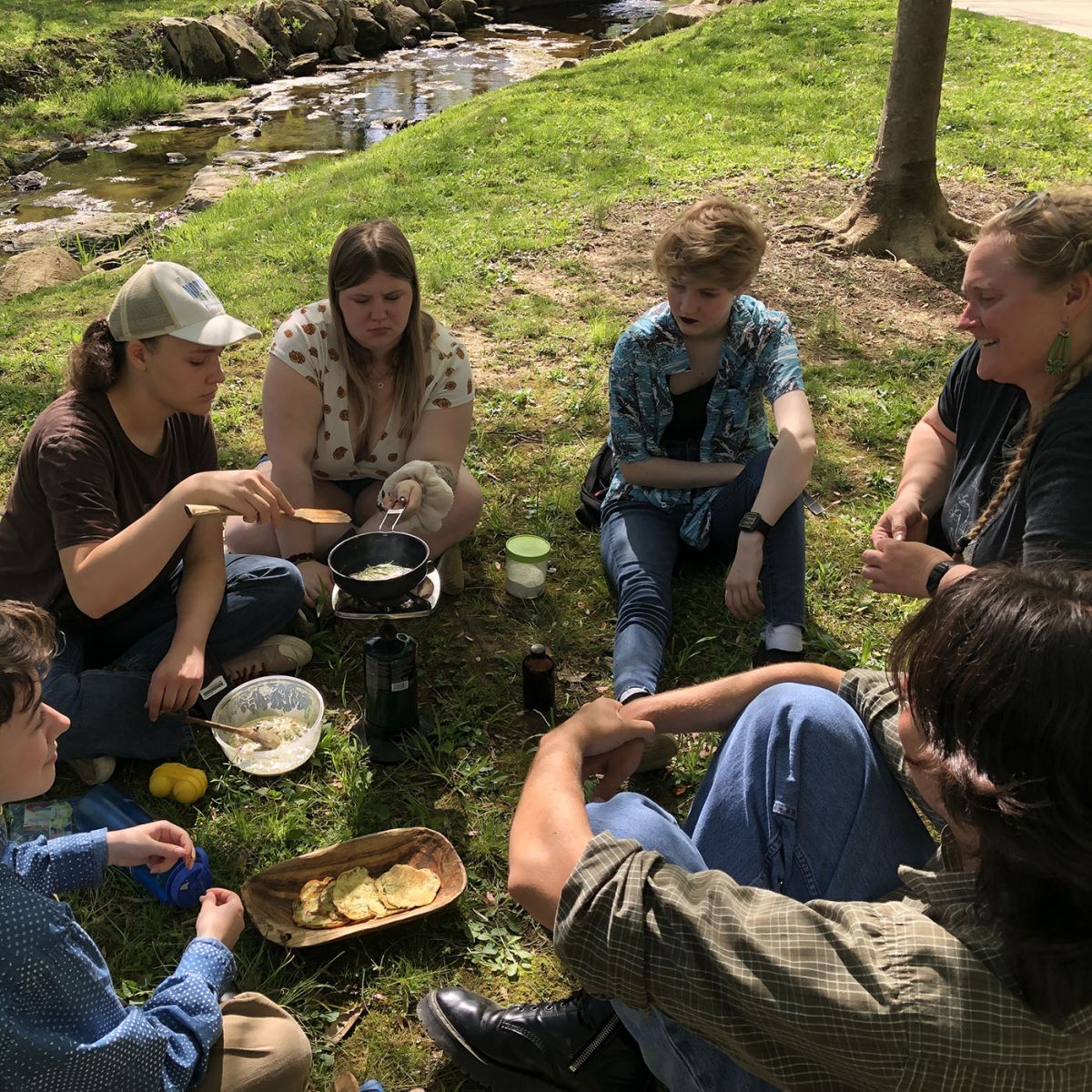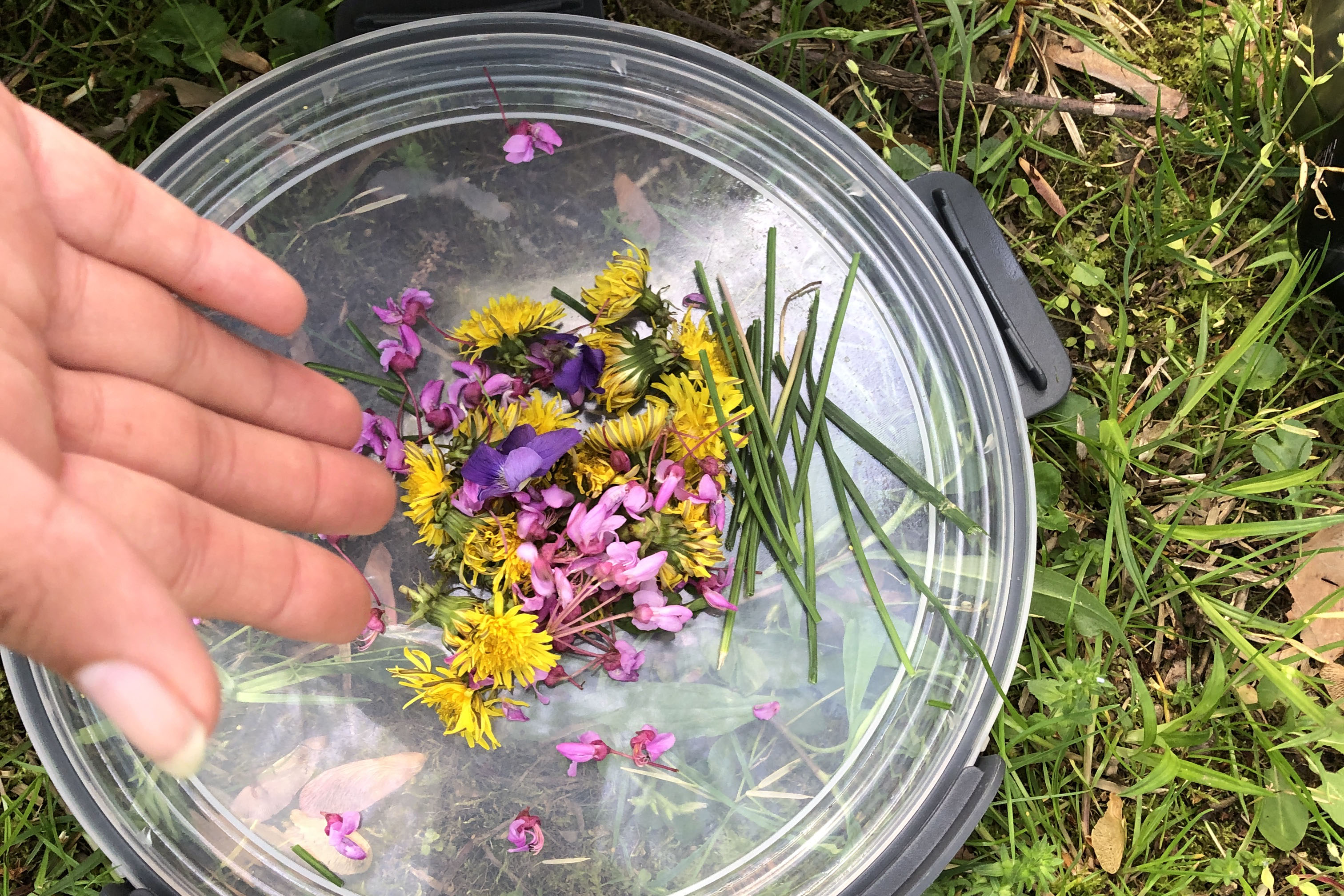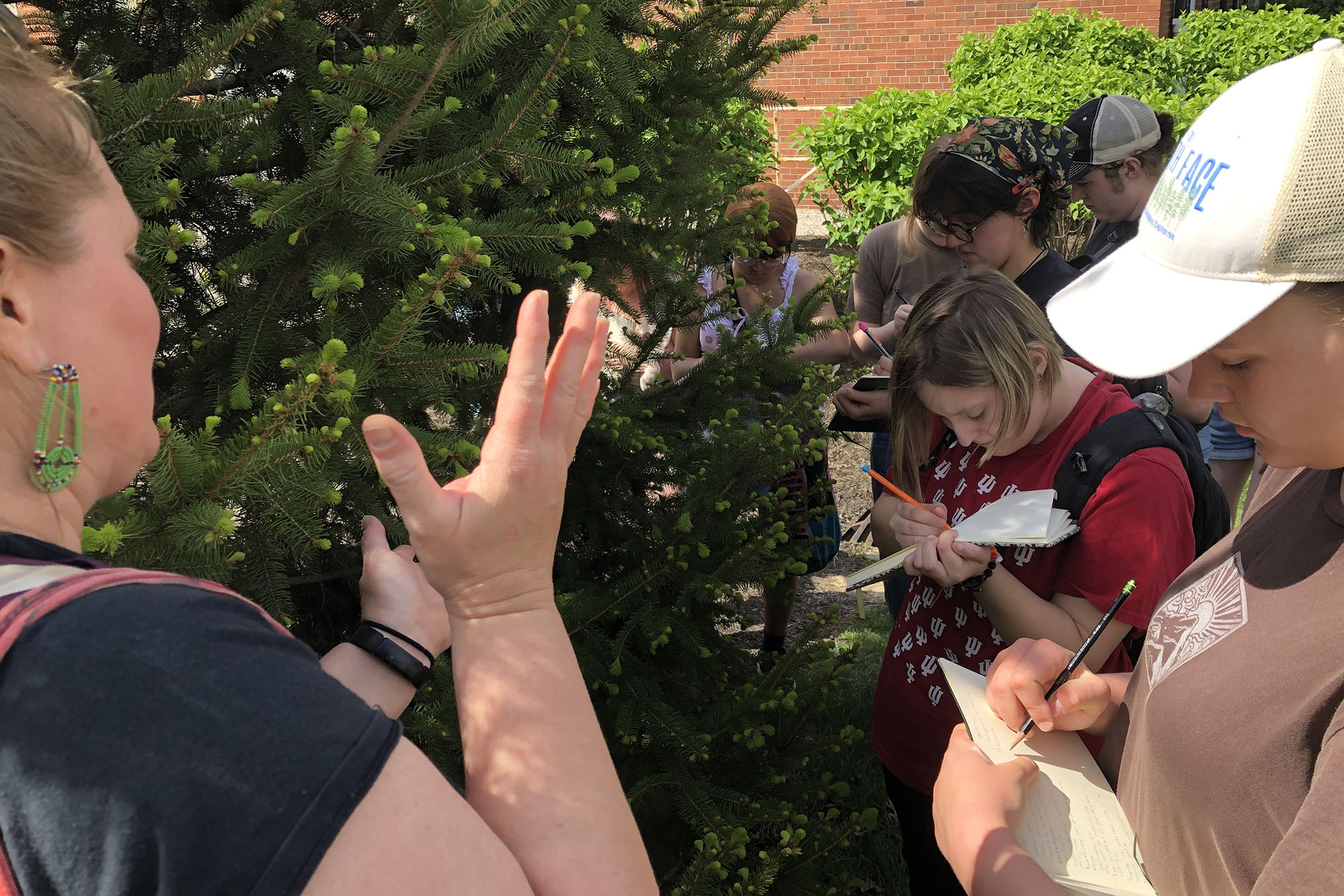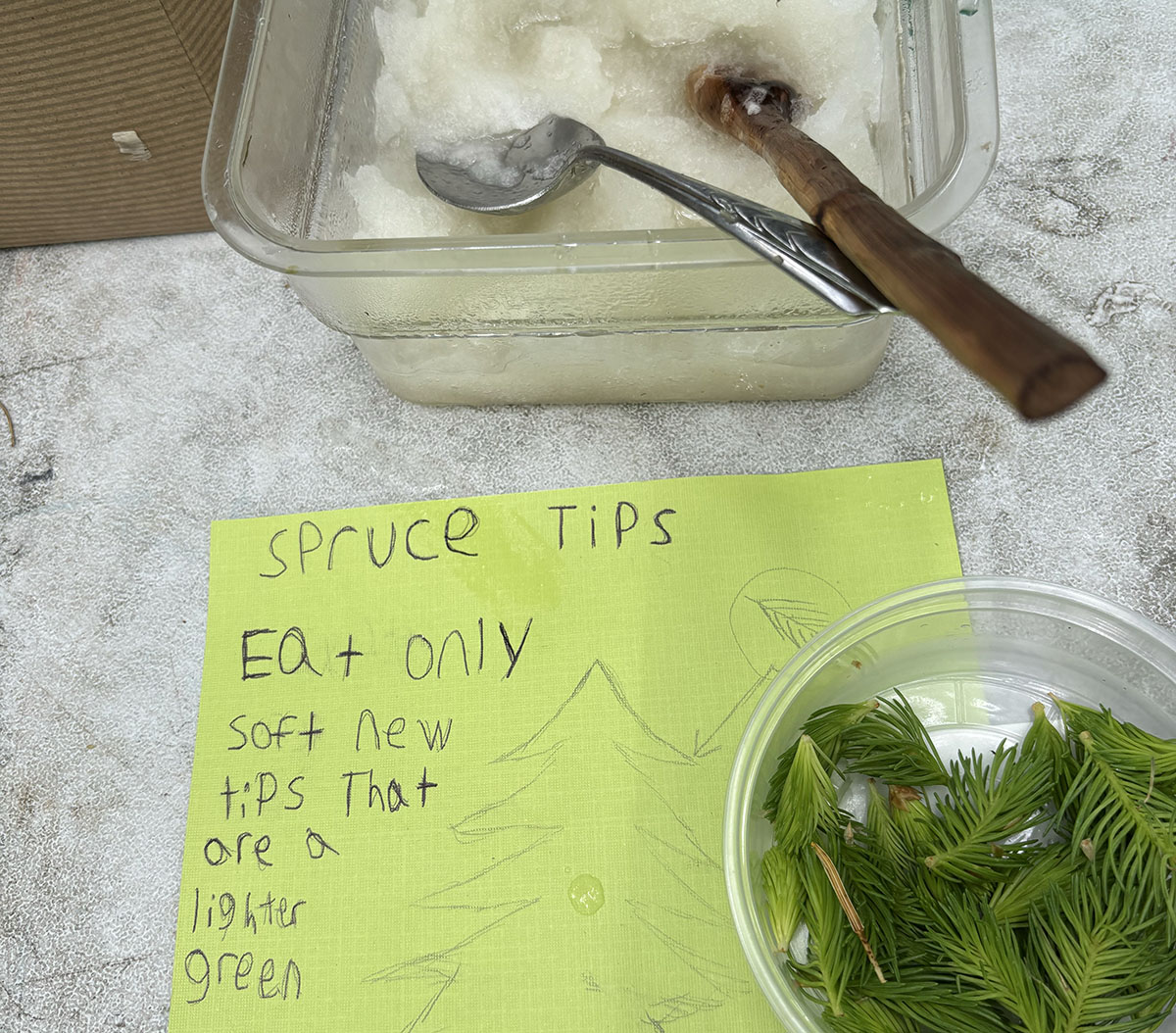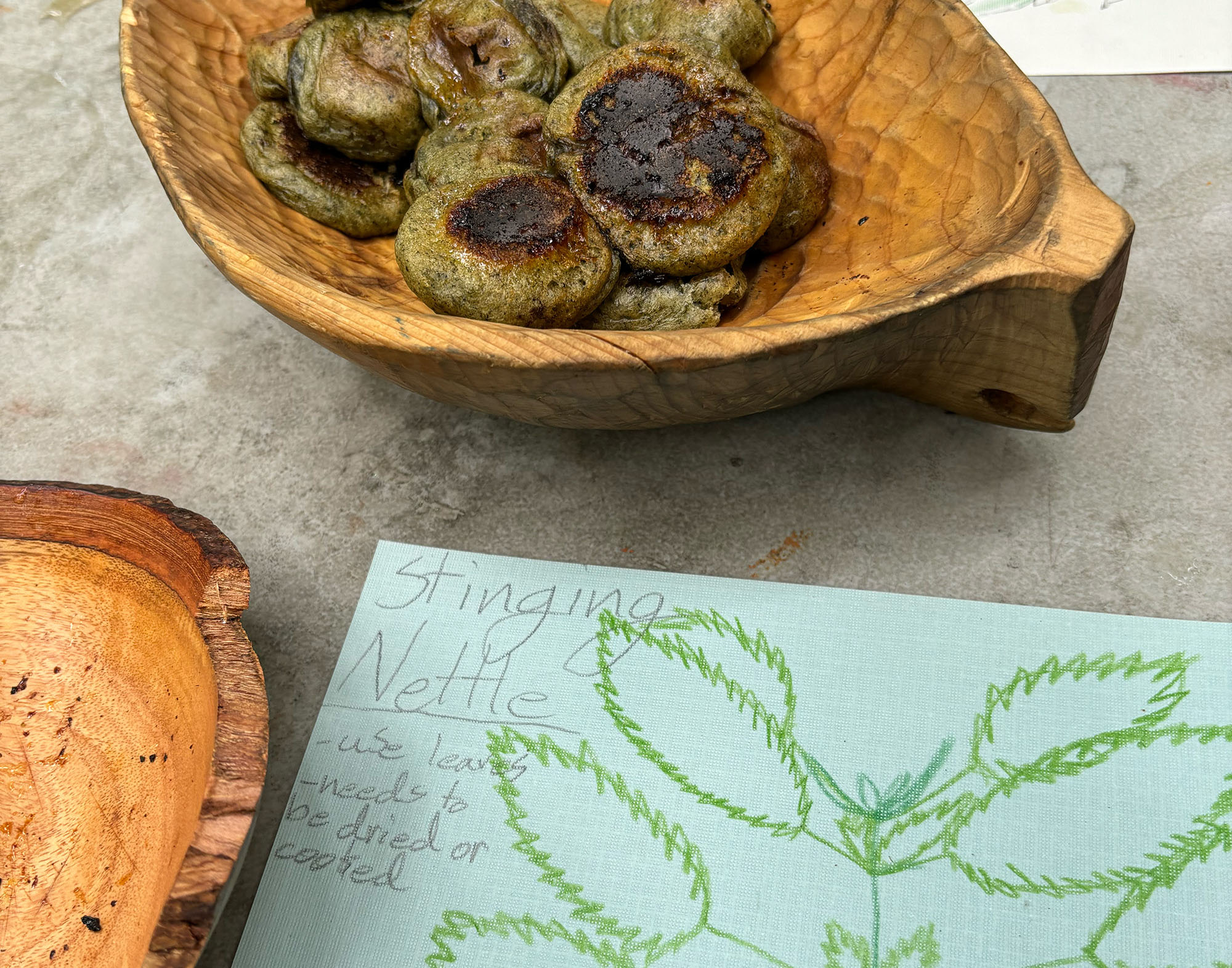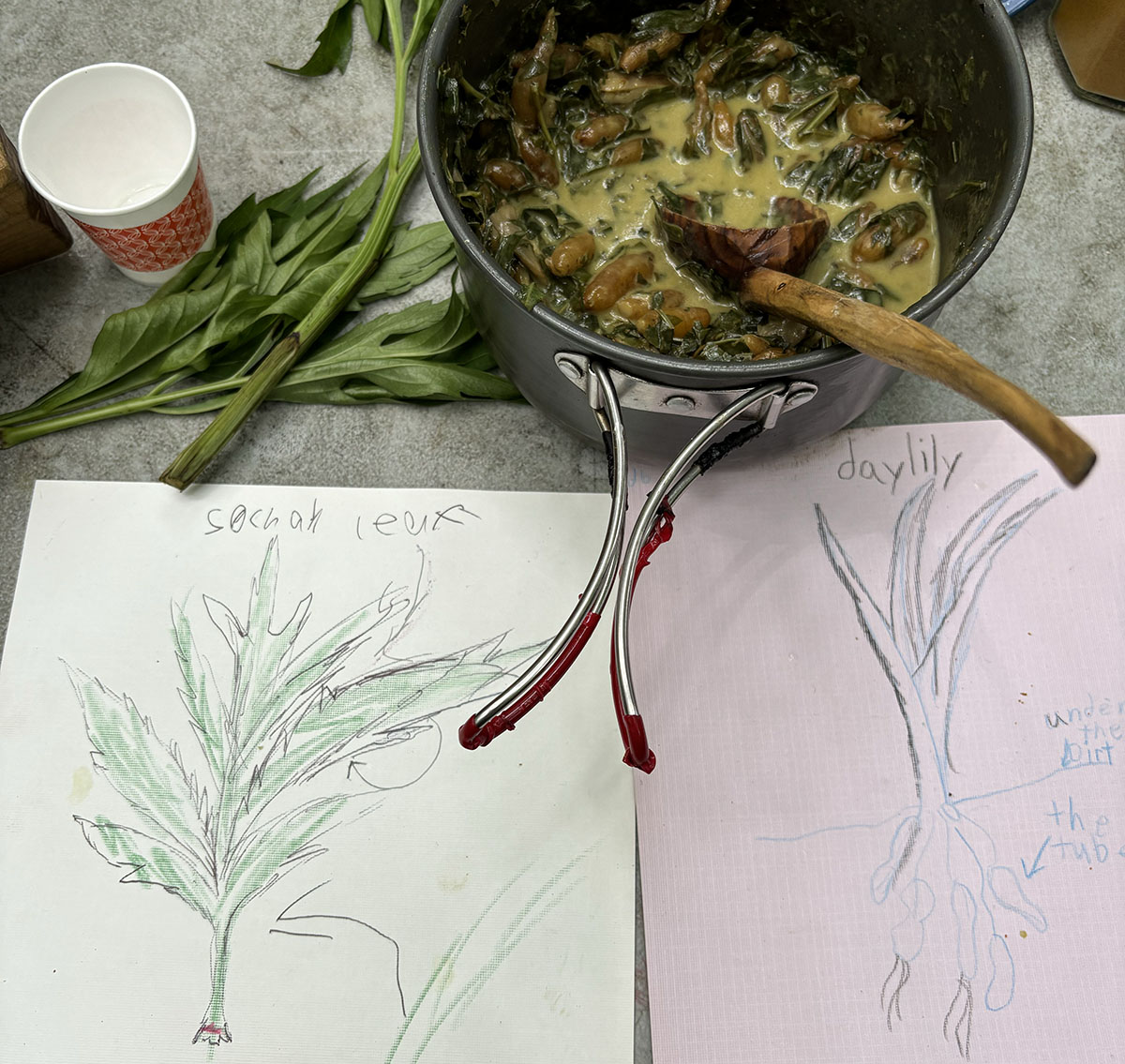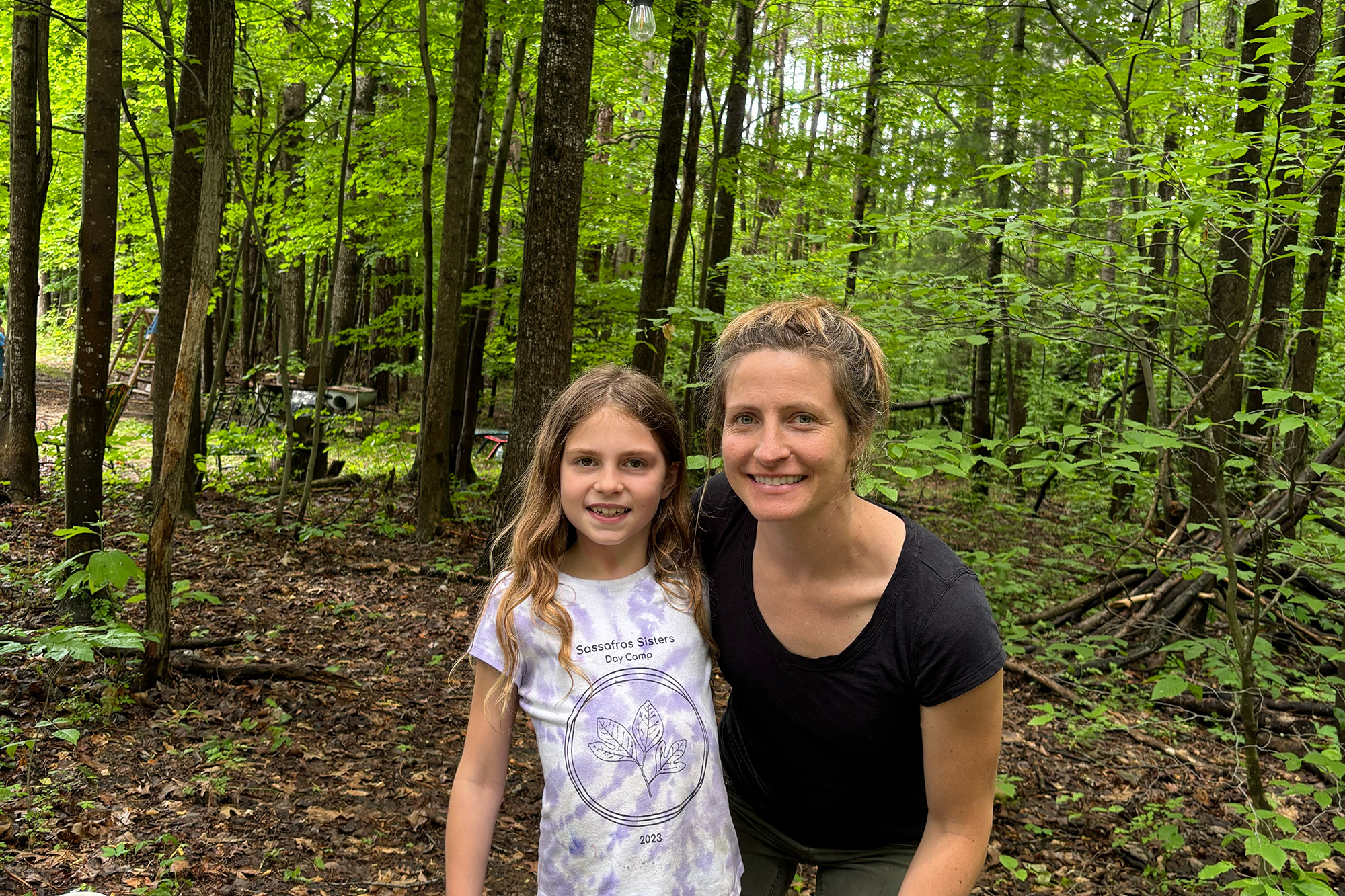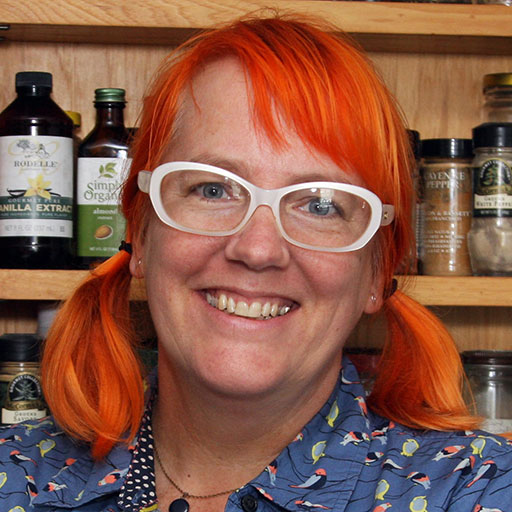00:00:04:22
Kayte Young
From WFIU in Bloomington, Indiana, I'm Kate Young, and this is Earth Eats.
00:00:10:04
Monique Philpot
And you're stepping into, you know, sinking, really, into this clay that's surrounding your feet. And there's also some sticks in there, and, you know, there's bugs and spiders on the water.
00:00:23:04
Kayte Young
This week on the show, we kick off the Earth Eats, Eats Wild special series, all about foraging and wild edibles. Monique Philpott, founder of a forest and folk school, takes us out to discover wild food in unexpected places and shares stories of growing up in two places with two cultures. We sampled treats from feasts prepared by children and by college students, and we talk about what loves got to do with it, with foraging, that is.
Stay with us.
Monique Philpot
What do you guys notice about the way that it's growing? What do you notice about the way that it looks, about the edging of the leaf? What do you notice in general? The colors?
00:01:09:27
Female
Do the leaves have teeth or are they smooth?
00:01:13:19
Monique Philpot
You might have to really look up close. Yeah, they do have teeth, but they're really, really subtle.
What else would you notice about this, especially if you look at the underside?
The veins are really pronounced, and they all grow vertically and they don't have any horizontally bits.
00:01:28:09
Monique Philpot
Yeah. The veins stick out like ribs on the underside. They're very, very clear. It used to be called rib wort just because wort, W-O-R-T, is the old name for herb, and this one has ribs and it's everywhere. It's in everyone's yard. It's in everyone's green spaces. It's all over the place. At one point, it was also called White Man's Foot because it's not native. It's from Europe. And everywhere that they went, it came along.
00:01:59:09
Kayte Young
Traipsing across lawns, along creek beds and in front of the IU Musical Arts Center, Monique Philpott takes her Wild Edibles class on a tour searching for springtime foods.
00:02:12:27
Monique Philpot
My name is Monique Philpott. I founded Soulcraft Bloomington. Soulcraft Bloomington is a forest and folk school. Everything that we do here is nature connected and it's also a celebration of older, slower ways of doing things, doing things by hand.
00:02:33:20
Kayte Young
Monique teaches this Wild Edibles class on the campus of Indiana University for the Collins Living Learning Center. She offers sessions in the spring and in the fall. The IU campus is surprisingly full of wild food. Some of it is unfortunately located next to noisy air handling units.
Monique Philpot
So this tree that I'm looking at, is it opposite or alternate? You can tell by the way the leaves are growing.
00:03:02:16
Female
Alternate.
00:03:03:10
Monique Philpot
Yes. It's alternate.
00:03:04:22
Female
Where is this tree growing?
00:03:06:26
Monique Philpot
Yeah. Partial shade. So they can be planted in the sun, but naturally they're gonna always grow on the edge. If you go to the edge of a forest, all these trees are gonna be on the edge. You won't find one in the middle of the forest.
00:03:18:20
Female 2
Are they native?
00:03:19:08
Monique Philpot
They are native. Right now this is the part that we eat, are the flowers. I've had them on cakes and cupcakes and even on fish or vegetables, on salad, in crepes. So we're gonna gather these flowers. In a few weeks they're gonna start growing little pods that look like bean pods, and those
pods are also edible. And when they're an inch big, you can collect them, and they're great. But right now we're just gonna get the flowers.
00:03:48:12
Taste one and see what flavors you notice. Is there some sourness, sweetness, saltiness? What do you notice? Here, you can take some.
00:03:57:09
Male
Ooh that's cool.
00:04:01:13
Monique Philpot
Yeah. It's refreshing right?
00:04:09:09
Kayte Young
Earth Eats has always been about connecting people with their environment through food. It's in the name. This week, I wanna welcome you to the first episode of our special series, Earth Eats, Eats Wild, all about foraging and wild foods. We invite you to take notice of your surroundings, to pay attention to subtle seasonal changes, and engage in memorable experiences with the natural world. To start off the series, I sat down with Monique Philpott in the Soulcraft studio just outside of Bloomington, Indiana.
00:04:51:02
It's a beautifully crafted space of wood finishes and natural light, nestled on the edge of a forest. To begin to grasp Monique's intense connection to the natural world, it's important to know how and where she grew up.
Monique Philpot
My mother is from Germany and my father is American, and so I grew up going back and forth. Where we were at in Germany was a really tiny village. All the houses are pretty close together, and then they're surrounded by fields that the people in the village own little plots of, but are wild.
Some people have gardens, a lot of orchard, and then all of that is surrounded by forest and all the villages are connected, you can walk to all of them.
00:05:35:24
And so we would spend three to four months there at a time. And it was just what you did when my family, who we were staying with, would come home from work, or school, or whatever, the most common thing to do was let's go wander around and walk through the fields and walk through the forest. And naturally, a part of that was collecting things for soups, or mushrooms, or whatever it was in season.
00:06:04:19
And there's also a big awareness of nature and the outdoors there. And so we were just always outside and always in the forest and always playing in the fields, and people often were growing. I mean, everyone had fruit trees and everyone was growing things that you would go outside and pick for tea. So it was just very common to go outside, get something that you would either use for tea or medicine or food.
00:06:36:28
And then we would come here, which was the suburbs of Indianapolis. We happened to have a really old house, one of the original houses in that area that had a large backyard compared to other people. So we did have a big yard and a little bit of forest, but generally we'd come here and no one did anything like that, at all. No one had fruit trees. People didn't go pick random things from the yard for teas, and people didn't think of this, the outdoor world as having medicine. 00:07:09:23
So, I grew up with this real dichotomy of place and seeing what each place had that was great, and what each place had that felt confusing, or was missing somehow, and I think that really pushed me on a path. There's many, you know, when you look back at your life, at least for me, there's many forks that I could have taken, but that really, I think, influenced my direction of wanting to create community that felt like a village and that was nature based or deeply nature connected. 00:07:47:25
When I was in Germany, in the village, we would always stay with my mother's sister and her family, and that was the house that my mother grew up in and my grandfather grew up in. I had cousins in that village and aunts and neighbors, the neighbors across the street. So, it was very much like feeling like I was growing up literally in a village where every day we would have, you know, the neighbors over for dinner or someone, cousins would come over for dinner.
00:08:22:20
They go to school for much less time during the day. So, I was there while they were in school, but they were only in school until noon, and then they would all come home using the city bus because they also don't have school buses, and all my cousins would come home. And what would happen is I would, in the morning, go visit my great aunt who was like the matriarch, and she would be cooking and gathering from the garden and all over, all morning.
00:08:50:27
I would do that with her, and we'd start cooking and we'd make these old, old, traditional meals, older ways of making noodles and by hand, everything by hand and from scratch. And she would prepare this big lunch, and all the cousins would come home and come to her house because their parents were potentially working. And so we'd all come there and we'd eat, and then we'd play and wander and do whatever.
00:09:14:24
But it very much was like being held by a basket. And I would walk down the street and, you know, you knew everybody and it was amazing. It was really amazing. Just being held by so many people, really, and having so much freedom and places to wander and walk. All the fields have paths that cars can't go on that are just for walking and biking. All the forests. There's benches everywhere because everybody walks and some people need breaks and like to sit for a while. 00:09:52:03
It was just idyllic in all the ways. And then I would come here and we didn't-- we kind of knew our neighbors, but not really. There was a lot more traffic. I did walk to friends' houses, but my dad would cross the street with me and get me to a sidewalk that was safe, and then I could walk the rest of the way. Everything was a lot more divided. It wasn't as common to eat with people. Like we always had meals with lots of people all around, and meals there were like this long ordeal. 00:10:28:27
You didn't eat and then get up and start cleaning right away. You sat there and would discuss politics. I always felt like they knew more about American politics than people here, or at least what was spoken. They were discussing things, you did not agree with everybody at the table. It was all ages talking. Little kids we'd go, you know, when I was little, we'd go and play while the bigger people would talk.
00:10:52:18
But it was hours for every meal. It's slow times, and that was just what it was. And then here it was very, a lot busier. And you get up and you start doing things and certain subjects seem to be taboo. You didn't really ask other people who they were voting for, or what they thought about this and that. There was a lot more fear of tension within a conversation. It's just very, very different. And also like the markets are different because you drive to the market here, it was like you got what you needed for the week.
00:11:33:09
You didn't stop by the market on your way home to grab a few things, and it wasn't quite as easy, it seemed. So you had to be a little more prepared. My mom cooked everything from scratch. We went out to eat maybe once a year, if that, and she made every meal, and she's a great cook. For her, she was trying to make it as much as she could, like it was there. But it was just very different. Everything was felt very isolated.
00:11:59:06
It felt lonely here.
00:12:18:28
I think that I have an affinity for plants that is just in my being. I remember being here and playing with dandelions as a four year old, but then I would also bring them in, and my mom and I would make things with it. We'd make tea or we'd flavor things with it. And so she was supporting this, you know, these activities of mine. And I was allowed to do that. So it was both places. It just really stood out a lot that when I was there, using plants for medicine is much more common. 00:12:58:12
Growing your own thing and just picking some things, or also as you're wandering around when you see things, you pick them and you have some snacks as you're walking. It's just that part is more common. So the love and the activities were in both places, but I think it was supported more there. And we would, you know, as kids, it was like we would go out, wander and, or as an older teen or young adult, we would go and gather mushrooms.
00:13:28:08
And there we brought them back, and it was the elders that would sit at the table and clean them off because they couldn't do the intensive wandering anymore. So it was cool, though, because they still had a part in the use and appreciation of these wild things, but they couldn't traverse the hills like we could. And so we'd bring them back. And then they would sit there and process all the mushrooms and get the dirt off and cut them, and it was like this wholesome thing.
Where here, as I was learning as a young adult, it was all on my own because nobody was ever doing this. When I would study these things and learn these things, I had to collect it all, do it all myself, because there was no one.
00:14:15:05
Kayte Young
When Monique headed off to college as a young adult, she started off as pre-med.
00:14:20:00
Monique Philpot
I was gonna study naturopathy, and along the way met some different mentors and started learning about community building and village building, and from indigenous mentors and people who learned from indigenous people. And so it was a very different way of looking at the world. You know, I think everyone has a natural connection to the outdoors. Maybe it's for some people. It's to animals. For me, it was always plants.
00:14:47:04
I loved plants, always. Even as a little kid, I was always outside making mud pies and, you know, playing with plants. So there's an affinity towards plants, for sure. So even when I was studying animal tracking and all, you know, fire building and shelter building, plants were always kind of my thing that really lit me up more than anything else. And at the time, like when I was in my 20s, I didn't know anyone here, anywhere, that was going out and foraging.
00:15:21:12
And so I was looking up a lot of old books, like Euell Gibbons wrote Stalking the Wild Asparagus. That was an old one that I was, like, devouring. And then Sam Thayer came out with some books, and he's amazing and has so much knowledge. And now there's so many people out there doing what I do, which is foraging and also teaching about foraging.
00:15:43:29
Kayte Young
Though she started out reading all the books she could get her hands on, Monique's approach toteaching diverges from the path of book learning.
Because I was able to study with different mentors here that have learned from indigenous people about culture, and often when I would talk with some of these people, it felt very similar to my experience as far as you live in this other culture, and then you come out of it and you see this kind of dysfunctional way of being. And so really, for me, wild edibles, I love wild edibles. It's about connecting to nature, connecting to the earth, understanding where your food comes from. 00:16:25:08
Those are all basic things. But really the most important thing is culture and feeling like you belong and having a sense of belonging. And when you collect wild edibles, it's natural that that starts to feel like, of course I belong here. I am caretaking the earth naturally because I want to see these things flourish and grow, and because I'm a part of it, I'm an important piece in this puzzle that is life on Earth.
00:16:56:07
And so creating a culture that allows for learning of all kinds, creating a culture where everyone can come and is at a different level of learning. Some people know nothing about wild edibles, and some people have some experience, or some people have a lot of experience, that they all feel like they can belong to the class, to the group, to the experience, and then they can all learn something new.
00:17:24:16
Because every time I go out and gather, you know, whatever it is, it's slightly different because of the state that the earth is in or whatever the seasons have been bringing that year. But for me, it's about really about culture and redesigning culture, and creating a place where learning, you know, a healthy learning environment, essentially.
00:17:49:11
Kayte Young
In her classes, whether through Soulcraft or on the IU campus, Monique puts the embodied learning philosophy into practice, by having students experience the plants through their senses. They will crush a leaf between their fingers, hold it close to the nose, and sniff. She has them keep a sketchbook to take notes and to draw the plants. And this isn't about making art, it's about looking, about really examining a plant and noticing all of the details.
00:18:24:16
Do the leaves connect to the stem directly across from each other?
00:18:27:22
Monique Philpot
Is it opposite or alternate? You can tell by the way that the leaves are growing.
00:18:31:22
Kayte Young
What about the shape of the leaf or the edges?
00:18:34:07
Monique Philpot
Do the leaves have teeth or are they smooth?
00:18:37:03
Kayte Young
What does the flower bud look like before it opens?
00:18:45:20
Kayte Young
The second half of each class includes preparing foods that they've gathered and tasting them right then and there. She wants that experience of tasting the food to happen at the same time that they've gathered it and studied it. It's another way to solidify the learning in bodily memory. 00:19:13:13
For the spring class that I attended on the IU campus, the students picked a spot along the creek bed, sat down on the ground, and started cooking. They were already familiar with Monique's portable camping stoves and other rudimentary food prep gear.
00:19:28:25
Monique Philpot
And we have crepe group, and we have salad group, two stoves.
00:19:34:05
Kayte Young
12
On this day, one group prepared a wild salad featuring the plantain, redbud, onion grass, violet leaves and flowers that they'd gathered on their walk, and another group prepared crepes, a simple flour, water, egg mixture with onion grass and the edible flowers fried in oil in a skillet on the camp stove.
00:19:53:13
Monique Philpot
Alright, here's all the stuff. You come and get it. You know what to do.
00:19:57:23
Kayte Young
The idea is to use the crepes as a sort of edible plate for the salad, like a flatbread or a tortilla. As they mix the batter and tore up leaves for their salad, they talked about their lives and discussed their plans for the final. On the last class of the semester, they're each required to prepare two dishes using wild edibles, for instance, lemon bars garnished with quince and violet flowers.
00:20:22:20
Female 3
I was thinking, I've never tried making them before, but people make these like shortbread cookies with like, pressed flowers on top.
00:20:27:02
Monique Philpot
Yes.
Female 3
And I was thinking maybe doing that.
00:20:29:01
Monique Philpot
Cool.
00:20:29:07
Female 3
And also like, maybe a savory scone with onion grass.
00:20:31:27
Monique Philpot
Oh, nice. Yeah. That would be perfect.
00:20:45:08
Kayte Young
13
Next, we'll visit another class that has a wild edible feast as their final project. This one is all kids. That's coming up after the break. Stay with us.
00:21:07:17
Kayte Young
We're back. I'm Kayte Young, and this is Earth Eats Eats Wild. On a late spring afternoon, I took a drive out to the Soulcraft studio on the outskirts of Bloomington for the last session of a wild edibles class that Monique offers just for kids. And like the college students for the final class, the kids prepared recipes featuring the wild foods they'd learned about in the weeks before. It wasn't as formal as a final exam.
00:21:37:22
It had more of the feel of an outdoor potluck, but the kids had clearly put some thought into presenting their dishes for their guests, namely me and their parents, who were due to pick them up any minute now. Each dish had a label next to it, with hand lettering stating what it was and
listing the wild plants or mushrooms they had used to prepare it. Some had even drawn the plant and mentioned other attributes, such as medicinal uses or tips on where to find it.
The kids stood before the dishes they had made and we went around the circle to hear about them.
00:22:13:00
Quinn
Yeah, my name is Quinn and we made lamb quartered patties,[INTERRUPTION] Oh yeah, they also have nettles in them.
00:22:20:04
Kayte Young
Okay, so they have lamb's quarters and nettles and then they're like little. They're kind of look like falafel.
00:22:25:04
Quinn
Yeah, they have walnuts. And we put some cheese in there.
00:22:28:12
Kayte Young
Oh, they sound really good.
00:22:30:09
Aaron
I'm Aaron and I made the same thing as Quinn did.
00:22:33:21
Tulsi
This is spruce tip sorbet with spruce tips, lime and sugar.
00:22:40:01
Kayte Young
Oh, and what is your name?
00:22:42:01
Tulsi
Tulsi.
00:22:42:29
Kayte Young
Once I spotted the sorbet, which was becoming a bit slushy in the bowl, I felt a sense of urgency for getting through the tour of the table. I wanted to make sure people could try the sorbet in its intended form. Luckily, it was a brisk spring afternoon and we were under tree cover. The next item was offered in small brown glass bottles with those black rubber dropper tops.
00:23:08:01
Shade
My name is shade and I made this tincture. We had honey in it, wild cherry and honey.
00:23:13:12
Kayte Young
So it's wild cherry bark.
00:23:15:12
Shade
Yeah.
00:23:16:25
Kayte Young
Okay. And what does it say on here? Good for.
00:23:19:06
Shade
Coughs.
00:23:19:22
Kayte Young
Okay.
00:23:21:07
Roz
I'm Roz, and I helped make the yakimochis.
00:23:26:15
Kayte Young
What are those?
00:23:29:17
Roz
They're kind of, like, really chewy bread.
Kayte Young
They look really great. What's in them?
Roz
There's nettles, there's rice flour, there's some powdered sugar and some water. And there's also a sauce to go with it, with cream cheese, sour cream and a bit of honey.
00:23:47:27
Kayte Young
Okay. So that's kind of a sweet thing.
00:23:49:22
Roz
Yes.
Kayte Young
Oh, wow. Very exciting. It looks really interesting and beautiful.
I couldn't get over how inviting the yakimochi looked on the plate. They were little shiny brown puffs about the size of a walnut with a velvety sauce on the side. Very intriguing.
00:24:08:09
Trat
Hi, I'm Trat and me and Alice made the daylily and sochan, and some wild mushrooms. And this is a curry.
00:24:21:07
Kayte Young
Okay, so it's a curry. It's made with daylily tubers.
00:24:25:06
Trat
Yes. Daylily tubers.
00:24:26:22
Kayte Young
Okay, because I see that in your drawing. And then I'm also seeing these little pod looking things,
but I guess those are tubers. That's really cool. And it's a curry.
00:24:35:15
Trat
Yes.
00:24:36:00
Kayte Young
Okay. And then what is this?
00:24:37:10
Trat
This is sochan. It has alternating leaves and we just use the leaves.
00:24:42:29
Kayte Young
Oh, so that's in there. You just have that there to kind of show us.
00:24:46:00
Trat
We also use some wild mushrooms.
00:24:48:04
Kayte Young
Oh what kind of wild mushrooms.
00:24:49:19
Trat
Oh, oyster mushrooms. Coral mushrooms. And yeah, I think that was it.
00:24:53:15
Alice
I'm Alice and I made the same thing as him. I made the curry.
00:24:57:09
Kayte Young
Can you tell me anything about what a daylily tuber might taste like?
00:25:02:04
Aaron
It's a little bit sweet. It's a potato. It's like a potato. Yeah.
00:25:05:16
Kayte Young
So it's kind of starchy.
00:25:06:18
Alice
It's like a potato, but a little bit sweeter. Right?
00:25:09:13
Kayte Young
Cool. And what about you?
00:25:11:21
Caspian
Oh, we made the cattails. And my name is Caspian. So it's just like the cattail core down close to the roots. And then we fried them. So that's what those are. And then we also worked on the quince syrup. It goes with the sparkling water that's made with quince flowers. So yep.
Kayte Young
It's really pretty. Now, what about you guys?
00:25:35:16
Iaia
My name is Iaia and we made scouring rush tea, and we put some mint and scouring rush in there.
00:25:44:16
Kayte Young
Okay, what is scouring rush?
00:25:46:23
Iaia
It's like, It's like a long tube. It's kind of like a bamboo, but like skinnier and smaller. Yeah. Oh, yeah. And it's also called dinosaur grass.
00:25:57:16
Kayte Young
But it's not like that one that's segmented what some people call horsetail. Some people call it horsetail. Yeah. But okay, it's. A different one.
00:26:04:10
Sonny
And my name is Sonny.
00:26:06:04
Kayte Young
Okay. And so what did you make with it? You made it. You made--
00:26:08:12
Sonny
We made tea.
00:26:10:00
Kayte Young
They also made a salad.
00:26:11:18
Children
With clover, violets, clovers, wild sorrel, dandelions. Yeah. There's plantain in it. And then comfrey flowers. Onion grass.
00:26:23:03
Kayte Young
Yeah. So are your parents waiting to come and check all this out? Okay. I want them to come because the sorbet is going to melt.
00:26:32:10
Kayte Young
The parents who had been hanging back now approached the table to hear about the recipes and to sample the goodies their kids had prepared. I headed straight for the spruce tip sorbet. It was delicious. Bright and sharp. Not too sweet. We'll be diving head over heels into spruce tips in another episode of the Eats Wild series, so I'll leave it there for now.
00:26:59:01
Kayte Young
I dropped some of my sorbet. It's so precious. Oh, I would love to try this mochi thing.
00:27:07:10
Aaron
Yakimochi.
00:27:08:15
Kayte Young
Yakimochi. Okay, I'm going to give that a taste.
00:27:14:25
Kayte Young
The yakimochi was so tasty. It had a crunch, then a chew, which I always love. And the flavors were great, especially with the creamy, slightly sweet sauce. I will likely try to learn how to make those.
00:27:27:27
Kayte Young
Have you had a chance to try everything?
00:27:29:13
Child
Yeah.
00:27:29:27
Kayte Young
What was your favorite?
00:27:31:07
Aaron
Sorbet.
00:27:32:02
Kayte Young
Sorbet?
00:27:33:10
Child
Or the Quince sorbet.I like the sorbet, and what are those things called?
00:27:38:29
Child
The Yakimochi?
00:27:39:24
Child
Yeah, those.
00:27:41:14
Kayte Young
I like the yakimochi, too. It's really good.
00:27:45:12
Kayte Young
The curry.
00:27:46:00
Female 1
It's actually tastes like curry.
00:27:47:10
Kayte Young
I want to try.
It's so good.
00:27:53:11
Kayte Young
Wow. The daylily tubers are really good. They have a great texture, and they're just, like, earthy.
00:27:58:28
Aaron
Took about 20 minutes to get all of them out because you got to. You have, like, a big dirt root, and then you got to pull all the dirt apart and get all the tubers out.
00:28:07:14
Kayte Young
So that's how you get it. So you harvest like a big chunk of daylily, and then you spread them apart and find the little tubers.
00:28:14:10
Aaron
And then there will be little things hanging off of it. So you got to tear those off and then you just cook them.
00:28:20:11
Kayte Young
Like how do you cook them in a skillet or like with what? Did you boil.
00:28:23:09
Aaron
Water. We boil them.
00:28:24:29
Kayte Young
Okay.
00:28:27:00
Kayte Young
I asked Monique about the daylilies. She said the class took a field trip to the Bloomington Community Orchard, a lovely space filled with many edible plants cultivated and wild.
00:28:38:09
Monique Philpot
But one of the things that they have is a lot of daylilies that are going crazy and taking up a lot of space. We dug so many and you just can't even tell. We didn't even make a dent. I mean, they're just so available. Yeah. And there's one girl here who's allergic to, like, she can't have any
nightshades, so she can't have tomatoes, peppers or potatoes, but she can totally eat all these all the tubers that we ate in this class. She can have all of them; no big deal.
00:29:04:21
Kayte Young
That's awesome.
00:29:05:08
Monique Philpot
Yeah.
00:29:07:03
Kayte Young
I really like the cattail. It's so good. Is now the time to harvest the cat tail of you're going to eat it like that? Or maybe earlier?
00:29:15:11
Aaron
Spring? No, definitely. I definitely say before the little hot dog thing shoots up.
Kayte Young
Okay. Okay.
Kayte Young
One of the students, Roz, was explaining the details of making the yakimochi to her mom, Emily.
00:29:34:29
Kayte Young
Hi. You are spending a lot of your childhood like learning about this stuff, and it's so neat when you
can showcase everything you've been learning all spring.
00:29:44:20
Roz
Yeah.
00:29:45:14
Kayte Young
So how long was the class?
00:29:47:24
Roz
Nine weeks long.
00:29:49:03
Kayte Young
Okay.
What are some of the kind of things you did? What are some of the things that you remember?
00:29:54:03
Roz
Well, all of the food that's here is what we made in the last few weeks. But we also had to harvest all of these. And these are just the remainings of what we harvest.
00:30:03:06
Kayte Young
What was one of the things that you learned about or harvested or searched for that was your favorite or that surprised you?
00:30:10:24
Roz
Probably the cattails.
00:30:12:11
Kayte Young
Oh yeah.
00:30:13:09
Roz
We would have to dig in the water to pull out the top and then get all the mucky water away.
00:30:19:22
Kayte Young
And so the part that you're harvesting is the part that's down there, like at the base of the plant.
00:30:24:03
Roz
There is-- There's about four leaves on the outside, and you would pull from the inside where there's just like sticky water from the plants that's not actually from it, so that it doesn't get the yucky water on them before we eat it like the inside.
00:30:39:18
Kayte Young
You pull the core out.
00:30:40:17
Roz
Yes.
00:30:41:10
Kayte Young
And then that part's really tender.
00:30:43:10
Roz
Yeah.
00:30:44:01
Kayte Young
It's really tasty. And so you had fun getting in the water and getting all that.
00:30:48:22
Roz
Yeah. It was a really fun.
00:30:50:18
Emily
I bet.
00:30:52:03
Kayte Young
What are some other things you remember from the class?
00:30:54:19
Roz
Well, we went to Shaw Oaks Park and gathered stuff to make, I think, salad. And it was flooded in the grass because there was a little divot like that, and it was completely flooded. And it was for ducks swimming around.
00:31:08:16
Kayte Young
Wow. So they were just like, oh, here's a pond.
Roz
Yeah.
00:31:12:08
Kayte Young
That sounds pretty fun. And you were just you harvested stuff to make salad with.
00:31:15:16
Roz
Yeah.
00:31:15:29
Emily
Her favorite food group is not vegetables. But when you gather the food, does that make you feel any different about trying new foods and new vegetables.
00:31:24:24
Roz
Yeah, I think when I gather them, it tastes better for some reason.
00:31:29:29
Kayte Young
I totally understand that.
00:31:33:04
Roz
When I like, see how it's made and like what they looked like before that they were all like, yeah, kind of yucky looking. I'm like, oh, well, actually, what I'm eating is actually totally delicious and really, like, good for you too.
Emily
And then she comes home and tells me, you know, we see things in our own yard, which because there are edibles just everywhere. And so she'll point things out that.
00:31:57:21
Kayte Young
What are some things that you found in your own yard after you'd learned about them here?
00:32:02:02
Roz
Well, for a long time I've known about dandelions and clovers, wood sorrel and nettle and all kinds of other stuff like violets and onion, grass and garlic, grass and all that kind of stuff. I've just always been able to know what that was and eat it. But then when I come here, I'm like, oh, I didn't know what a cattail was edible.
00:32:23:25
Kayte Young
Roz's mom, Emily, has also taken classes with Monique.
00:32:27:13
Emily
One of my favorite things that I've ever tried, and it wasn't a spring season thing, a fall season, but Kentucky coffee beans, which I knew people used for coffee, like for tea, you know, as kind of a coffee substitute. And it's a native to the Americas and but you guys had them really young and fresh when they were still tender and you boiled them. And I couldn't believe they were, like, nutty and soft and just delicious.
00:32:52:24
And giant, yeah. And I have thought about them many times since then. So this fall, every time you drive past that park. [INTERRUPTION] Yeah. I'm like, those are the trees. Yeah.
00:33:03:24
Kayte Young
That's the cool thing about this is like, you start to see those places like, oh, that's going to be good. Yeah.
00:33:11:01
Kayte Young
Emily says she's really impressed with all of the things her daughter is learning.
00:33:14:27
Emily
At this point. My eight year old daughter is kind of surpassing a lot of my own knowledge and it's so cool. She's been doing classes with Monique since she was just about three years old, actually, right? Right before she turned four is when she took her first class with Monique. And so that's four or five years now of of learning. And of course, it's not always wild edibles. It's all kinds of things. But yeah.
00:33:39:05
Kayte Young
Well, and it feels like the kind of thing that she'll remember too, because she'll probably do it year after year. Next spring, she'll remember the stuff she harvested this spring. So it just kind of stays with.
00:33:49:24
Emily
Definately, and, and like, you know, there's really something too, like when you have your own hands in the dirt doing; it's not like you're reading about it or you're hearing someone else talk about it. You're doing it. And yeah, I think it'll stick. It's really cool.
00:34:05:10
Kayte Young
That was Emily. She's Roz's mom, one of the students in the Wild Edibles class for kids at
Soulcraft Forest and Folk School in Bloomington, Indiana.
00:34:18:07
Kayte Young
I had the chance to visit the Wild Edibles Feast at the conclusion of their spring course. Everything I sampled was delicious and unique and a couple of them I am definitely going to try myself. It's time for another break. When we come back, we'll hear more from Monique about the power of a plantain leaf and how a visit to a swamp might just change your life. Stay with us.
00:34:56:18
Kayte Young
Kayte Young here. We're back with our special series, Earth Eats, Eats Wild.
00:35:05:03
Kayte Young
And we're checking back in with Monique, this time with her wild edibles class on the campus of Indiana University. They had harvested plantain, a plant you can find in almost any lawn here in the US and also in Germany, where Monique spent about half of her childhood. The class gathered the leaves for their spring salad, and Monique shared a story of one of the other common uses for plantain.
00:35:30:28
Monique Philpot
When I was growing up, we would always take this if you ever got stung by a bee, a wasp or anything, or had something stinging and itchy, you would take this leaf, chew it up and stick it on there. And so I kind of grew up doing that. And then I did notice that here no one would do that like no other of my friends would do that. And eventually I stopped doing it. But I also wasn't getting stung so much until I became a beekeeper.
00:35:56:18
And as a beekeeper, I do wear a full suit typically, if I'm really getting into the hives because there's thousands of bees and you do get stung sometimes even with that gear, but not very much, and I would always take the plant and chew it and put it on my stings. And there was one time when we
had captured a wild swarm and we were moving the hive to a different location. And it was at night, which they're supposed to be calm at night.
00:36:27:03
And they were pretty upset. Some of the bees started to get out, but in the moment you can't stop what you're doing. And it was at night. And so we just kept going and I felt myself getting stung on the wrist. They were crawling up my suit, so they were crawling up here and stinging me. They were getting stopped by my watch, I think, and stinging me on my wrist, which is a bad spot. I got stung five times and again we had to keep going.
00:36:52:28
You couldn't stop what you were doing. I was kind of lazy and I thought, well, you know, nobody in this country even uses plantain anyway. I'm always like the weirdo. Nobody here is using it and everybody seems fine, so I'm. I'm just going to forget about it and go home. And it was stinging. It was stinging pretty good. By the time I got home, my whole hand was swollen. Like, if you were to blow up a latex glove.
00:37:18:05
That is how my hand looked. And I started to put ice on it and my arm started to swell. It was a red line. You could see the red, the whole thing was red, and it just started to move up my arm and move up my arm. Slowly. Everything was giant and bright red. Moving up, moving up, moving up, moving up. And at that point it's like, you know, an hour later and it's moving up my arm. And by the time that comes to this area, that's where you start to get into trouble because you don't want anything going to your heart.
00:37:48:05
And so I'm watching it. And at that point my husband was like, you know, maybe you should take some Benadryl. It keeps moving. And it got about mid bicep and I started to hallucinate. And [LAUGHS] and so he was like, you need to take the Benadryl. So I took the Benadryl. I went to sleep. Everything was fine.
00:38:11:16
Kayte Young
Monique finally took the Benadryl and it took care of the reaction she was having to the bee stings. Monique now suspects that she's been allergic to bees all along.
00:38:21:11
Monique Philpot
I have that in my family. My aunt is also severely allergic to bees. Like hospital level going, you know, getting stung by a bee.
00:38:29:11
Kayte Young
But perhaps she never knew because she always used plantain on her bee stings. And the plantain did such a good job.
00:38:37:26
Monique Philpot
That is what this plant is known for. If you can use it fresh, like I did on a on a sting or something, it draws the venom out.
00:39:04:18
Kayte Young
As you can tell. Monique is a storyteller. I asked her to share a memorable story from her foraging classes.
00:39:13:14
Monique Philpot
When you start to look for plants and mushrooms and these things, I think it elicits a similar feeling to an Easter egg hunt, which most people in this culture understand. Like that, that fun of finding things and that that feeling of like racing to the thing that is sticking out in your field of vision and hoping it's the gift that you want it to be.
00:39:37:21
Kayte Young
The treasure on this particular hunt.
00:39:40:04
Monique Philpot
Mud bananas. The lotus root. I don't always take classes there because it is so edgy for people, because you have to go into a swamp or a swamp like area. We have a lot of clay and leaves that forms like a layer of muck and, you know, stepping in muck through water that is dark that you cannot see. You can't help but wonder what is in the water that could bite you or hurt you. But sometimes there's a group of people that are up for adventure and want to try something new. 00:40:18:27
I'll take them out to gather Lotus, and you gotta take your shoes off and go barefoot, because the muck can steal shoes and you won't be able to get them back. And so you got to go barefoot. You know, you're getting wet and you're stepping into, you know, sinking really into this clay that's surrounding your feet. And there's also some sticks in there. And, you know, there's bugs and spiders on the water and the lotus leaves, and then you can gather the pods which have the nuts, which are delicious and amazing and beautiful and unique.
00:40:54:11
But this, this plant itself is so beautiful, and you really can't experience it unless you're willing to go into the muck. So I have to tell a lot of stories about being adventurous and the gifts that come from trying new things. And some people are like, let's do it. And some people are like, okay, I'm going, but you're dragging me. And some people are like, I'm going to stay here on the shore and just watch all of you as you scream and shout and shriek.
00:41:22:23
But we go out and gather these things. And the mud. Bananas are particularly tricky in this area because you have to find water that's not that deep that you can kneel in, and you have to find a plant and follow the leaf stem down into the muck, and you have to dig the clay around this leaf stem that's going now into the earth, really, and you cannot see what you're doing. It's all just based on feel.
00:41:53:06
And that's so rare to do something that you cannot see, that we who are so sight and visual based, cannot see what we're doing. It's. And so you end up with a group of people all in the water, in the muck, kneeling, just feeling along what feels like a little golden thread. And then at the end, hopefully it doesn't fork off and go to another plant. Hopefully there's the elusive mud banana at the end, which is the lotus root, and it's just so beautiful and amazing and delicious.
00:42:29:07
And when someone finds one, they stand up and the look of joy and triumph. Everybody shouts and screams and is happy. And we might not find that many, but it is the most exciting thing. And you cannot help. You cannot help but be in your body. And you know, some people are like, do you know what's in the water? Are there snapping turtles in here? And I'm like, don't think about it. There are probably snapping turtles.
They're much more afraid of us than we are of them. You just have to let some things go and also focus on what you're doing. And I think that's where some of the students like Robin, who you spoke to, it's like it's the most fun that they'll have compared to many other things, because you can't be in your head, you can't think about what you have to do later on. You can't think about the chores that still all the millions of things that need to get done.
You can't think about the things that are stressing you out. You can't think about the conversation you had earlier that had tension in it. You can't think about your calendar, and you can't think about your phone because you had to leave it on land because you don't want to drop it in a swamp. And so you're just you're literally taken away from all the stressors of life and put in this situation where we're all in it together.
We're looking for this golden egg that hopefully appears, you know, this elusive thing together. And you have to pay attention to what you're doing and you're working. You're working together at it. And hopefully, you know, at least one person or a few will find the this amazing gift of the Lotus. It's so immersive and sensory, and I think, I really think that's at the root of, of, um, of the joy of it.
00:44:21:08
Monique Philpot
That's an extreme example. Super fun. Not all foraging is in a swamp, but there's there's a similar lighter thread to all, all foraging where it's still exciting. You're still looking for this amazing thing. You still are dreaming of the thing that you're going to make. And then with a group of people, it's like, you can't help but be present. And that's a rare gift these days, I think.
00:44:50:19
Monique Philpot
There is kind of a survival, apocalyptic feel to nature and nature connection right now in the world. And so a lot of people are just, you know, some of them are just excited to, like, be able to survive out in the wild, and some are fearful of what the future might hold. And I always say in the beginning that I do it for the love of nature and for the love of the world around me. All those other things will just happen.
00:45:21:26
They'll just happen naturally. I'll learn how to survive because I'm learning these things. But for me, it's been a journey of seeing the beauty of the world that's around me all the time, making friends with everything wherever I go, you know, wherever I go on earth, I know that I can get to know the birds, or that I can connect with plants or literally the soils in different ways. So I always will feel home no matter where I go. It's again, back to that sense of belonging. And there's been many studies that have found that when you teach people, or especially children, to love something before they're feeling like it's threatened or are fearful of it, they're going to protect it more. And so before talking about the destruction that is happening, I want them to feel a love, a deep love for it first. And there's a lot of negativity and there's a lot of hard things having to do with the earth and nature right now in the world.
00:46:25:25
And those things need to be recognized, for sure. But I need to love the earth first, to feel totally affected by those things
00:46:35:20
Monique Philpot
With wild edibles or wild medicinals or foraging in general. It's just so fun. And it's it's shocking to people to go out and see. In my own backyard, there are hundreds of plants that can be used for all these different things. And then to start to use them and taste them and make things with them, it's exciting and it opens up the world.
00:47:06:27
Monique Philpot
I would like to say that it is my honor to use, teach, be involved with the wild edible plants of this area. I hope to do the earth and all of them justice, and I want to honor the people who kept this knowledge alive, which are the indigenous knowledge keepers of this whole country, and that there are some that decided that teaching the outsiders, or the settlers or colonialists, that teaching them would actually be better for the earth than not.
00:47:49:02
And I have to give thanks to them, because I wouldn't feel whole if they hadn't shared their knowledge with me. On culture, on mentoring, on plants specifically. Give thanks for all the people that take a risk by coming to a class they show up. I feel like there's so much gratitude that I have for the land, for people, for teachers. I just want to make sure I say that.
00:48:20:27
Kayte Young
Thank you so much, Monique, for talking with me.
Monique Philpot
Yeah. No problem.
00:48:39:04
Kayte Young
Monique Philpot, she's the founder of Soulcraft Bloomington, a forest and folk school offering classes and workshops on foraging for wild food and many other nature based arts and skills. We'll be hearing more from Monique throughout our special series, Earth Eats, Eats Wild. We have two more episodes featuring wild foods of spring, including the elusive morel mushroom. backyard flowers and tasty greens, plus a fresh flavored evergreen that just might knock your socks off. 00:49:14:23
I hope you'll join us!
Kayte Young
Be sure to visit our website, eartheats.org for photos, links and recipes. We'll be sharing lots of bonus wild edible fun on Instagram and Facebook, so be sure to follow us at Earth Eats. I would love to hear about your adventures in Wild Edibles. Send us an email. Eartheats@gmail.com.
00:49:47:10
Kayte Young
That's it for this episode of Earth Eats Eats wild. Thanks for listening and we'll see you next time.
The Earth Eats team includes Eoban Binder, Alexis Carvajal, Alex Chambers, Toby Foster, Leo Paes, Daniella Richardson, Samantha Schemenauer, Payton Whaley and we partner with Harvest Public Media. Special thanks this week to Monique Philpott, to the students of the spring 2024 IU Wild Edibles class, and to the students and parents of the Wild Edibles for kids class at Soulcraft, Bloomington.
Earth Eats is produced and edited by me, Kayte Young. Our theme music is composed by Erin Tobey and performed by Erin and Matt Tobey. Additional music on the show comes to us from Universal Production Music. Our executive producer is Eric Bolstridge.







